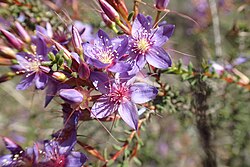Biology:Calytrix violacea
| Calytrix violacea | |
|---|---|

| |
| Scientific classification | |
| Kingdom: | Plantae |
| Clade: | Tracheophytes |
| Clade: | Angiosperms |
| Clade: | Eudicots |
| Clade: | Rosids |
| Order: | Myrtales |
| Family: | Myrtaceae |
| Genus: | Calytrix |
| Species: | C. violacea
|
| Binomial name | |
| Calytrix violacea (Lindl.) Craven[1]
| |
| Synonyms[1] | |
| |
Calytrix violacea is a species of flowering plant in the myrtle family, Myrtaceae and is endemic to the southwest of Western Australia. It is a shrub with linear to narrowly egg-shaped leaves with the narrower end towards the base, and purple, star-shaped flowers.
Description
Calytrix violacea is and erect to sprawling shrub that typically grows to a height of 15–45 cm (5.9–17.7 in), its young stems softly hairy. The leaves are linear to narrowly egg-shaped with the narrower end towards the base, mostly 4–5 mm (0.16–0.20 in) long and 0.8–1.2 mm (0.031–0.047 in) wide on a petiole 0.4–1 mm (0.016–0.039 in) long with thread-like stipules at the base. The flowers are star-shaped and arranged in clusters of 5 to 25 on the ends of branches that continue to grow after flowering. There are bracts 3–7 mm (0.12–0.28 in) long at the base of the flowers and clusters. The flowers are 12–15 mm (0.47–0.59 in) wide, the sepals broadly egg-shaped, 1.8–2.5 mm (0.071–0.098 in) long, the petals egg-shaped, purple, 5.5–7.0 mm (0.22–0.28 in) long and 2.8–3.5 mm (0.11–0.14 in) wide. There are 55 to 75 stamens and staminodes, the longest with filaments 4.5–5.5 mm (0.18–0.22 in) long and the anthers are yellow. Flowering mainly occurs in September and October.[2][3]
Taxonomy
This species was first formally described in 1839 by John Lindley, who gave it the name Lhotskya violacea in his book A Sketch of the Vegetation of the Swan River Colony.[4][5] In 1987, Lyndley Craven changed the name to Calytrix violacea in the journal Brunonia.[6] The specific epithet (violacea) means "violet".[7]
Distribution and habitat
Calytrix violacea grows in shrubland and woodland in sandy soil on plains and hills in the wheatbelt between Goomalling, Northam, Brookton and Quairading in the Avon Wheatbelt and Jarrah Forest bioregions of south-western Western Australia.[2][3]
Conservation status
Calytrix violacea is listed as "not threatened" by the Western Australian Government Department of Biodiversity, Conservation and Attractions.[3]
References
- ↑ 1.0 1.1 "Calytrix violacea". https://biodiversity.org.au/nsl/services/apc-format/display/104309.
- ↑ 2.0 2.1 Thiele, Kevin R.; Keighery, Gregory J.; Nge, Francis J.; Rye, Barbara L. (2022). "Three new Western Australian species related to Calytrix violacea (Myrtaceae: Chamelaucieae).". Nuytsia 33: 230–232. https://florabase.dpaw.wa.gov.au/science/nuytsia/1034.pdf. Retrieved 8 October 2022.
- ↑ 3.0 3.1 3.2 "Calytrix violacea". FloraBase. Western Australian Government Department of Parks and Wildlife. https://florabase.dpaw.wa.gov.au/browse/profile/5487.
- ↑ "Lhotskya violacea". APNI. https://biodiversity.org.au/boa/instance/apni/748757. Retrieved 8 October 2022.
- ↑ Lindley, John (1839). A Sketch of the Vegetation of the Swan River Cology. London: James Ridgway. p. vii. https://babel.hathitrust.org/cgi/pt?id=hvd.32044106366024&view=1up&seq=15. Retrieved 8 October 2022.
- ↑ "Calytrix violacea". APNI. https://biodiversity.org.au/boa/instance/apni/533159. Retrieved 8 October 2022.
- ↑ Sharr, Francis Aubi; George, Alex (2019). Western Australian Plant Names and Their Meanings (3rd ed.). Kardinya, WA: Four Gables Press. p. 336. ISBN 9780958034180.
Wikidata ☰ Q15396264 entry
 |


